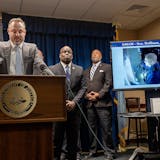Narayana Kocherlakota stood alone once again on Wednesday, solidifying his reputation as the most dovish member of the Federal Open Market Committee.
The president of the Federal Reserve Bank of Minneapolis said the central bank should continue the asset purchase program known as quantitative easing and keep the federal funds rate low at least until the one-to-two-year inflation outlook returns to 2 percent. He was the only member of the committee to take that position.
Inflation, running about 1.5 percent according to the Fed's key measure, is still too low, Kocherlakota has argued.
"He was looking for more of a continued focus on low inflation, that was the reason for his dissent," said Craig Bishop, manager of fixed income strategies for RBC Wealth Management. "Certainly that remains warranted."
Kocherlakota plans to release a statement explaining his dissent Friday, but his speeches in recent months have signaled that he believes low inflation is as much of a problem as high inflation, because it creates doubt among households and businesses that the Fed is truly aiming for its 2 percent inflation benchmark.
"In my view, inflation below 2 percent is just as much of a problem as inflation above 2 percent," Kocherlakota said in a speech in Billings, Mont., two weeks ago.
Kocherlakota, a former University of Minnesota professor who grew up in Winnipeg, has undergone a transformation since he took over the Minneapolis Fed in 2009.
Initially considered an interest-rate hawk, he said in 2010 that high unemployment was largely the result of a mismatch between workers' skills and available jobs, not something the Fed could cure with low interest rates.

![A black bear stopped after crossing Big Bay Road on Madeline Island, the largest of the Apostle Islands in Wisconsin, on Monday, May 31, 2021. ]](https://arc.stimg.co/startribunemedia/PWNYGIY3WTSWDBOGOYD775DPP4.jpg?&w=80&ar=1:1&fit=crop)

